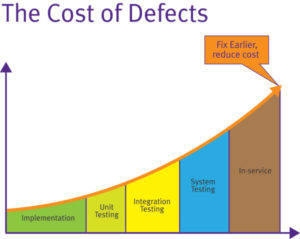The early detection of defects, in a process, is important for the successful execution of a project. However, the detection and prevention of defects is a significant challenge in the software industry.
Although the proverb “Better safe than sorry” may seem to be entirely disconnected from software programming, pay heed, it is the single mantra that can save a ton in maintenance cost for a project. Defects or rather bugs like we not so endearingly call them, are the sneakiest of them all. Irrespective of the severity of it, the later it is found the more it does you harm. Safe to say, the cost of defects is proportional to the time taken in finding them.
A large portion of the cost of software development consists of error removal and reworking on projects. The reworking process costs more than the initial process so early detection of defects during the design and requirements phase is necessary to avoid this extra expense. A large number of defects usually occur in the initial stages of a project and early defect detection will lower the overall cost of the project.
How Defects do arise?
When the error is found in the requirement or the design phase, it is easier to correct, but if the error is found in the user acceptance test it becomes expensive. The reason as to why this is the case is, even in the most trivial cases, the root cause analysis and regression testing take a lot of time later in the development cycle. In most cases, the defect found in later stages is not caused by a missing line of code or mistyping, it is more subtle and difficult to find.
It is highly unlikely that a defect caused due to minor errors will be overlooked by testers who test every scenario in detail. This means there is more extensive testing and detailed analysis that needs to be done to figure what went wrong. If the final product is an integration of multiple platforms or libraries, the analysis is ten folds more difficult. Even if it is fixed it still would require additional regression testing and integration testing to confirm the fix.

Reason for Defects:
Most defects require the team to understand what caused the defect other than faulty code. Was it a fault in the process, does the process need improvement or was there any test case that was blocked till the last minute or was the test coverage not good enough or was there last minute changes to the code. These need to be a whole lot of brainstorming on the probable cause. This effort translates to additional cost of the defect.
With the stringent timelines and agile process followed by companies, the numbers of defects are on the rise. Robust measures need to be taken, a lot of preventive mechanisms need to be in place, all-embracing code review needs to be done, more test cases needs to be written, and best practices needs to be followed. This will make sure the system is sturdier and the number of unforeseen bugs will be less translating into lower maintenance cost.




